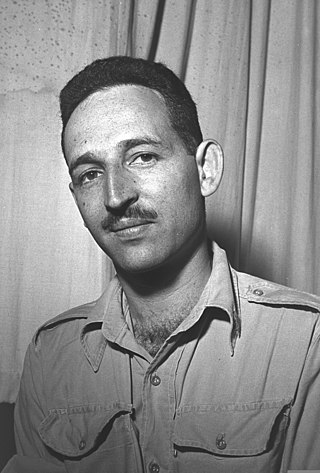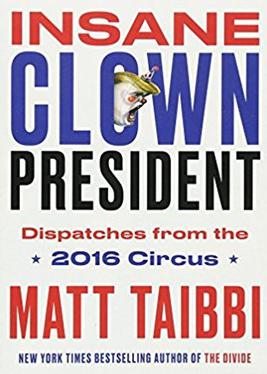
A submachine gun (SMG) is a magazine-fed automatic carbine designed to fire handgun cartridges. The term "submachine gun" was coined by John T. Thompson, the inventor of the Thompson submachine gun, to describe its design concept as an automatic firearm with notably less firepower than a machine gun. As a machine gun must fire rifle cartridges to be classified as such, submachine guns are not considered machine guns.

The Thompson submachine gun is a blowback-operated, selective-fire submachine gun, invented by United States Army brigadier general John T. Thompson in 1918. It was originally designed to break the stalemate of trench warfare of World War I, but early models did not arrive in time for combat.

Uziel "Uzi" Gal was an Israeli firearm designer who invented the Uzi submachine gun.

John TaliaferroThompson was a United States Army officer best remembered as the inventor of the Thompson submachine gun.

David Talbot is an American journalist, author, activist and independent historian. Talbot is known for his books about the "hidden history" of U.S. power and the liberal movements to change America, as well as his public advocacy. He was also the founder and former editor-in-chief of the pioneering web magazine, Salon.

A drum magazine is a type of high-capacity magazine for firearms. Cylindrical in shape, drum magazines store rounds in a spiral around the center of the magazine, facing the direction of the barrel. Drum magazines are contrasted with more common box-type magazines, which have a lower capacity and store rounds flat. The capacity of drum magazines varies, but is generally between 50 and 100 rounds.
The weapons master, sometimes credited as the armorer, weapons specialist, weapons handler, weapons wrangler, or weapons coordinator, is a film crew specialist that works with the property master, director, actors, stunt coordinator and script supervisor. The weapons master is specifically responsible for maintaining control of any prop weapons, including firearms, knives, swords, bows, and staff weapons.

Outrageous Betrayal: The Dark Journey of Werner Erhard from est to Exile is a non-fiction book written by freelance journalist Steven Pressman and first published in 1993 by St. Martin's Press. The book gives an account of Werner Erhard's early life as Jack Rosenberg, his exploration of various forms of self-help techniques, and his foundation of Erhard Seminars Training "est" and later of Werner Erhard and Associates and of the est successor course, "The Forum". Pressman details the rapid financial success Erhard had with these companies, as well as controversies relating to litigation involving former participants in his courses. The work concludes by going over the impact of a March 3, 1991 60 Minutes broadcast on CBS where members of Erhard's family made allegations against him, and Erhard's decision to leave the United States.
Greg Downs is an author and historian. He is best known for the Flannery O'Connor Award-winning short story collection Spit Baths (2006) and his histories of the United States Civil War.

Firearm magazines are used "jungle style" if they are fixed together side by side, often with tape. The spare magazine may be pointing downwards in relation to the one fitted to the weapon.

The M3 is an American .45-caliber submachine gun adopted by the U.S. Army on 12 December 1942, as the United States Submachine Gun, Cal. .45, M3. The M3 was chambered for the same .45 ACP round fired by the Thompson submachine gun, but was cheaper to mass produce and lighter, at the expense of accuracy. The M3 was commonly referred to as the "Grease Gun" or simply "the Greaser," owing to its visual similarity to the mechanic's tool.

Alexander Zaitchik is an American freelance journalist who writes on politics, media, and the environment. He has written for The Nation, The New Republic, the Intercept, Rolling Stone, the Guardian, Foreign Policy, the Baffler, the International Herald Tribune, Wired, the San Francisco Chronicle, and The Believer, among others. He was a staff writer and editor at the New York Press, the eXile in Moscow, and was the founding editor at the Prague Pill, an alternative newspaper in the Czech Republic.

Auto-Ordnance was a U.S. arms development firm founded by retired Colonel John T. Thompson of the United States Army Ordnance Department in 1916. Auto-Ordnance is best known for the Thompson submachine gun, used as a military weapon by the Allied forces in World War II, and also notorious as a gangster weapon used during the Roaring Twenties.

Fist Stick Knife Gun: A Personal History of Violence is a memoir by American social activist Geoffrey Canada. Beacon Press published the book on January 31, 1995.
Selden Spaulding Edwards is an American writer and educator. His first novel The Little Book was a New York Times bestseller. His second novel The Lost Prince, a sequel to The Little Book, was published by Dutton in 2012.

Insane Clown President: Dispatches from the 2016 Circus is a non-fiction book by Matt Taibbi about Donald Trump and the 2016 United States presidential election. The book contains illustrations by Rolling Stone artist Victor Juhasz. Taibbi's choice of title for the book was motivated by Trump's marketing style and is wordplay based on the name of American horrorcore band Insane Clown Posse. His work was inspired by Hunter S. Thompson, who had previously published Fear and Loathing on the Campaign Trail '72.

There There is the debut novel by Cheyenne and Arapaho author Tommy Orange. Published in 2018, the book follows a large cast of Native Americans living in the Oakland, California area and contains several essays on Native American history and identity. The characters struggle with a wide array of challenges, ranging from depression and alcoholism, to unemployment, fetal alcohol syndrome, and the challenges of living with an "ambiguously nonwhite" ethnic identity in the United States. All of the characters unite at a community powwow and its attempted robbery.

Timeline: A Visual History of Our World is a children's picture book by Belgian author Peter Goes that was published by Gecko Press in 2015. It illustrates the timeline of the world's events from the prehistoric eras to the present, spanning the Big Bang theory, Medieval Europe, civilizations, and the 2010s.
Stembridge Gun Rentals was a prop weapons provider to the US movie and television industry from approximately 1920 through 2007. During its tenure, nearly every American movie or television set was supplied by Stembridge for their firearms and blanks.














